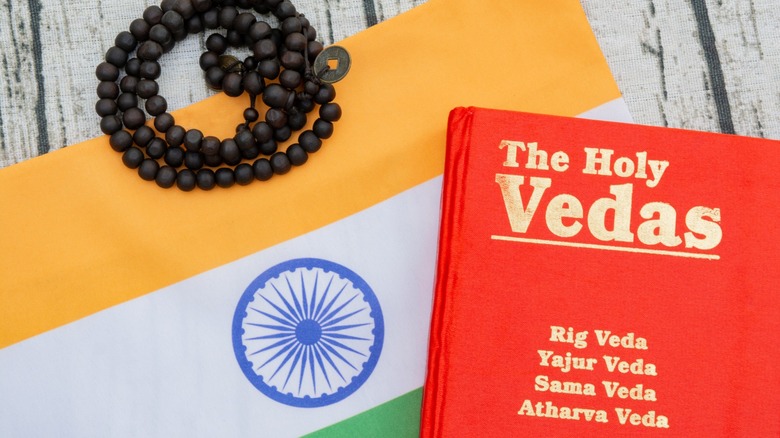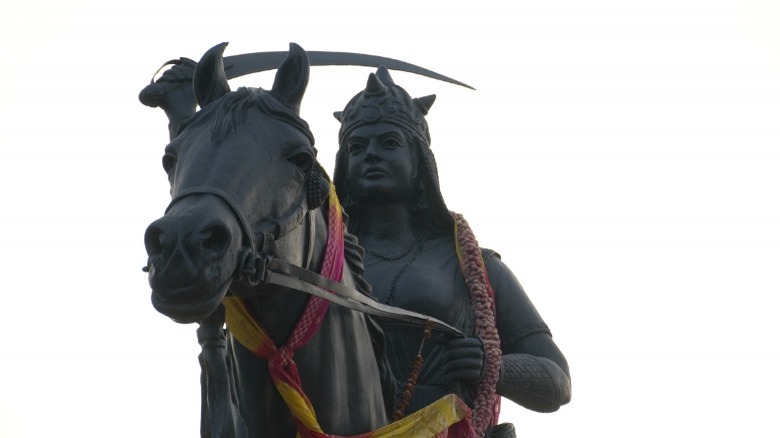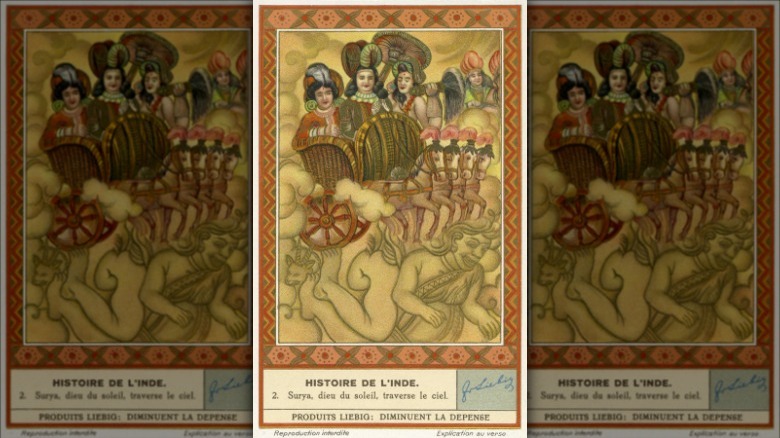The Legend Of The One-Legged Queen Vishpala Of The Rigveda
The older a book, the more likely it is to contain tantalizing, unsolvable historical mysteries. That's true for the Vedas, a set of ancient Hindu texts, considered to be some of the oldest manuscripts in the world, according to Hindu Scriptures. The first of them, the Rigveda, is estimated to date from anywhere between 6000 B.C. and 500 B.C., depending on who you ask (via New World Encyclopedia). Buried deep in the Rigveda — which consists of 10 books and hundreds of hymns — are a few fascinating references to a female warrior named Vishpala.
Hindu Scriptures explains the Vedas had a major influence on Hindu religion and society. Like many religious texts, they were meant to provide a guide on how to live correctly — in this case, how to achieve the Hindu tenets of Dharma (order and righteousness), Artha (financial security), Kama (pleasure), and Moksha (liberation) (via Chopra Center). The texts feature many different Hindu gods as well as human figures, some of whom really existed. So who was the mysterious Vishpala?
The warrior queen
According to the text of the Rigveda, Vishpala was fighting "in Khela's battle" (Book One, Hymn 116, verse 15). Scholars have identified Khela as a king and Vishpala as a queen, possibly his wife or daughter (via "The Power of the Dharma" page 63). M.N. Bopardikar wrote an article on the historicity of the Hindu mystic Agastya, supposedly Khela's personal priest, and concludes both king and priest may be real historical figures. This could mean Vishpala is, too.
During the battle, according to the Rigveda, Vishpala's "leg was severed" (Book One, Hymn 116, verse 15). Fortunately, the Ashvin gods came along to give her a new one, made of iron, "that she might move" when the battle began again. Other verses reiterate that the Ashvin gods "a new leg for Vishpala provided" and "gave Vishpala power to move" (Book One, Hymn 118, verse 8 and Book Ten, Hymn 39, verse 8). The verses are significant because they contain a rare, ancient reference to a prosthetic limb (via "Design, Development, and Optimization of Bio-Mechatronic Engineering Products").
The verses note that the battle happened at night, but its purpose isn't clear. Some scholars assume Vishpala was fighting to protect her kingdom. However, the Rigveda calls it a "battle of a thousand spoils" in which "Vishpala [was] seeking booty" (Book One, Hymn 112, verse 10). This suggests a more financial motivation for the battle.
The powerful Ashvin gods
Each of the Rigveda hymns that mention Vishpala are odes to the Hindu Ashvin gods, Nasatya and Dasra. They are the twin sons of the sun god Surya, known for helping him raise the sun each morning by flying ahead of him in a golden chariot, creating the dawn (via World History Encyclopedia). As suggested by Vishpala's story, they have curing powers and act as healers in Hindu tradition. Hindu Scriptures, which identifies Vishpala as Khela's wife, calls them "compassionate" and notes that she's far from the only person they helped. Book One, Hymn 112, gives numerous examples of it. The hymn, which describes Vishpala as "powerless to move" after her injury, is entirely dedicated to asking for the Ashvin gods' help. The writer repeats the phrase "Come hither unto us, O Ashvins, with those aids" in every verse. Hymns 116 and 117 in Book One relate their "wondrous deeds" and "heroic exploits."
Hymn 117 contains another Vishpala reference, saying the Ashvins "established Vishpala again." This could mean either restoring her to health or to power. Unfortunately, it remains unclear when, where, or if she ever reigned.


